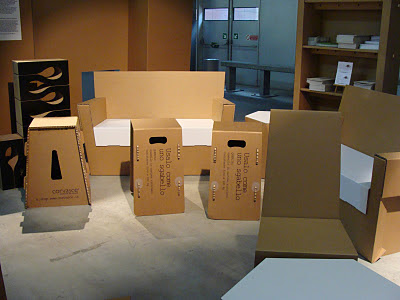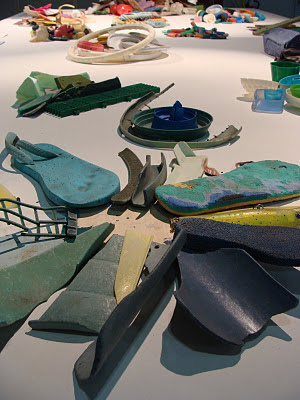Born in the Czech Republic, Svetlana Kuliskova graduated from the SPST Fashion Institute and Faculty of Fine Arts of VUT of Brno with a range including the visual arts, painting and design; she maintains a particular interest in textile materials and technologies. Svetlana Kuliskova expresses now herself through modern tapestries ARAKNE and novel fibre products, such as scraps from textile production, but that reflect ancient technologies. She developed new textile materials in collaboration with the Dyloan Studio di Milano. She is interested in the reuse of existing materials to test it's untapped potential as well as for the ecology.
For additional info:
www.svetlanakuliskova.com
www.spaziogerra.it
http://sparkling.iaiamichi.com/it/espositori/svetlana_kuliskova.html
Nata in Repubblica Ceca, Svetlana Kuliskova si diploma nell’istituto di Moda di Brno. Dopo la laurea in Videoarte, Multimedia, Performance presso la facoltà VUT di Brno, pur spaziando nelle arti visive, nella pittura e nel design, mantiene un particolare interesse per i materiali e le tecnologie dei tessuti. Svetlana Kuliskova si esprime ora attraverso arazzi moderni ARAKNE,prodotti con fibre inedite, ad esempio gli scarti della produzione tessile, ma che riprendono tecnologie antiche. Ha sviluppato nuovi materiali tessili in collaborazione con lo studio Dyloan Studio di Milano. È interessata al riuso di materiali esistenti per testarne le potenzialità inespresse oltre che per l’istanza ecologica.
Per maggiori informazioni:
www.svetlanakuliskova.com
www.spaziogerra.it
http://sparkling.iaiamichi.com/it/espositori/svetlana_kuliskova.html
Welcome to Bio-Fashion, the blog about eco-fashion and eco-lifestyle where you can read news and interviews with companies, associations and opinion leaders.
Search This Blog
30.1.12
Eco-visual artist
Labels:
eco-sustainability,
Svetlana Kuliskova,
visual arts
26.1.12
A good coffe at MACEF!
I have been invited by Marco Capellini at the MACEF event "Un caffè con..." to talk about sustainability in living: the result was a nice talk about topics such as requirements, barriers and opportunities to growth.
It was nice being on the Corvasce bench of the speakers together with Marta Pesamosca.
Here are the stands that have been selected along the green map by Bio-Fashion.
959
Junk Collection by Marillina Fortuna
Noi non buttiamo niente by Galliano Habitat
Silenzio Stampa by Alice Visin
Chimajarno
It was nice being on the Corvasce bench of the speakers together with Marta Pesamosca.
Here are the stands that have been selected along the green map by Bio-Fashion.
959
Junk Collection by Marillina Fortuna
Noi non buttiamo niente by Galliano Habitat
Silenzio Stampa by Alice Visin
Chimajarno
23.1.12
NICE project in Copenhagen!
Few days ago I interviewed Jonas Eder-Hansen, Development Director of the Danish Fashion Institute about responsible fashion and the activity of NICE - Nordic Initiative Clean & Ethical.
NICE is a project under the Nordic Fashion Association. The Nordic Fashion Association was initiated in 2008, after Danish Fashion Institute, Oslo Fashion Week, The Swedish Fashion Council, Helsinki Design Week and Iceland's Fashion Council had met to cooperate with The Nordic Council of Ministers to launch Nordic Look during Riga Fashion Week.
Which brings us to nicefashion.org, a web tool for consumers, designers and people involved in the textile business, as well as a forum where professionals can find resources and exchange information. Based on the cradle-to-cradle principle, the site aims to inspire towards more environmentally safe and ethical design and sourcing; while involving the customer in the process through wash, care and prolonged-use issues.
How can fashion companies be "responsible"?
NICE clearly defines a Code of Conduct identifying the most important actions that companies need to put in practice to be "sustainable" in Working conditions, Health and Safety, Environment, Ethical behaviour, Auditing(see Nice Code of Conduct Manual).
The sustainable fashion is today only a small segment of the total, what are the barriers to the development and what are the conditions for growth?
Consumers need to be more active and need to ask themselves more critical questions. In food and in personal care this has been happening: consumers asked themselves “What am I putting in my mouth? What am I digesting? What am I putting on my face?”. Now consumers should start to ask themselves questions related to the safety and sustainability of the products that they wear. Consumers play a big role: they should care more about ethics and fair trade.
The other need is related to the political framework for the consumer engagement: educating the consumer on washing temperatures and on how to dry clothes…etc… is fundamental.
Consumers should be driven to a higher sensibility using a more fun and engaging language, for example using the “gamification”, actual online games or videogames could be used. Of course you need knowledge and promotional elements (i.e. coupons) in order to make it work and this is just for a certain (more mass) positioning.
Public/private partnerships are fundamental to close the loop: i.e. engaging companies that sell washing machines to reduce the water waste or control better the temperature during the washing of the clothes.
Together with the consumers, political framework and public/private partnerships also the supply should make a further change by improving its aesthetic statement: the “eco” should not be a limitation but an additional value of beautiful and “good” fashion, not wrinkled or itchy.
Companies need to integrate their first attempts in sustainability into a real long term strategy.
The next step will be the having the new “sustainable black dress”.
Consumers are changing as more options arise, selecting products that inspire their dreams. Fashion companies should talk to the consumers relating to issues that speak directly to the consciousness. Trend forecasters put a lot of emphasis on the issue.
Think about the luxury brands: spending so much money on a bag will not be possible anymore for the only objective of giving a certain status symbol to the consumer. Social and environmental awareness will help to create and reinforce the new status symbol.
The eco-sustainable fashion industry: what has changed comparing the new “eco-sustainable” supply chain with the “traditional” supply chain?
The prerequisite is to create a stronger relationship with suppliers, increase the auditing (code of conduct) and trusting relationships (exchange of knowledge and resources). Thanks to the partnership between company and supplier the exchange will be on both sides: quality products on one side and a more educated work force thanks to knowledge development programs to the suppliers. It is fundamental to train the supply chain and engage on an individual base. H&M for example is trimming the number of its suppliers and is on the right track of building the right relationships.
For more info visit: http://www.nicefashion.org/en
NICE is a project under the Nordic Fashion Association. The Nordic Fashion Association was initiated in 2008, after Danish Fashion Institute, Oslo Fashion Week, The Swedish Fashion Council, Helsinki Design Week and Iceland's Fashion Council had met to cooperate with The Nordic Council of Ministers to launch Nordic Look during Riga Fashion Week.
Which brings us to nicefashion.org, a web tool for consumers, designers and people involved in the textile business, as well as a forum where professionals can find resources and exchange information. Based on the cradle-to-cradle principle, the site aims to inspire towards more environmentally safe and ethical design and sourcing; while involving the customer in the process through wash, care and prolonged-use issues.
How can fashion companies be "responsible"?
NICE clearly defines a Code of Conduct identifying the most important actions that companies need to put in practice to be "sustainable" in Working conditions, Health and Safety, Environment, Ethical behaviour, Auditing(see Nice Code of Conduct Manual).
The sustainable fashion is today only a small segment of the total, what are the barriers to the development and what are the conditions for growth?
Consumers need to be more active and need to ask themselves more critical questions. In food and in personal care this has been happening: consumers asked themselves “What am I putting in my mouth? What am I digesting? What am I putting on my face?”. Now consumers should start to ask themselves questions related to the safety and sustainability of the products that they wear. Consumers play a big role: they should care more about ethics and fair trade.
The other need is related to the political framework for the consumer engagement: educating the consumer on washing temperatures and on how to dry clothes…etc… is fundamental.
Consumers should be driven to a higher sensibility using a more fun and engaging language, for example using the “gamification”, actual online games or videogames could be used. Of course you need knowledge and promotional elements (i.e. coupons) in order to make it work and this is just for a certain (more mass) positioning.
Public/private partnerships are fundamental to close the loop: i.e. engaging companies that sell washing machines to reduce the water waste or control better the temperature during the washing of the clothes.
Together with the consumers, political framework and public/private partnerships also the supply should make a further change by improving its aesthetic statement: the “eco” should not be a limitation but an additional value of beautiful and “good” fashion, not wrinkled or itchy.
Companies need to integrate their first attempts in sustainability into a real long term strategy.
The next step will be the having the new “sustainable black dress”.
Consumers are changing as more options arise, selecting products that inspire their dreams. Fashion companies should talk to the consumers relating to issues that speak directly to the consciousness. Trend forecasters put a lot of emphasis on the issue.
Think about the luxury brands: spending so much money on a bag will not be possible anymore for the only objective of giving a certain status symbol to the consumer. Social and environmental awareness will help to create and reinforce the new status symbol.
The eco-sustainable fashion industry: what has changed comparing the new “eco-sustainable” supply chain with the “traditional” supply chain?
The prerequisite is to create a stronger relationship with suppliers, increase the auditing (code of conduct) and trusting relationships (exchange of knowledge and resources). Thanks to the partnership between company and supplier the exchange will be on both sides: quality products on one side and a more educated work force thanks to knowledge development programs to the suppliers. It is fundamental to train the supply chain and engage on an individual base. H&M for example is trimming the number of its suppliers and is on the right track of building the right relationships.
For more info visit: http://www.nicefashion.org/en
10.1.12
Bio-Fashion is back from holidays
During my holidays in Morocco I have seen some original recycling ideas: have a look at these rubber frames. You will find them in the workshop of the young artisan Abdellah Ikki in Riad Zitoum Kdim in Marrakech.
For those of you who still haven't visited Marrakech remember to put it among your top travel destinations!
Durante la mia vacanza in Marocco ho visto alcune idee originali riciclo: date un'occhiata a queste cornici di gomma. Le troverete nel laboratorio del giovane artigiano Abdellah Ikki nel Riad Zitoum Kdim di Marrakech.
Per chi di voi non ha ancora visitato Marrakech ricordatevi di metterla tra le vostre destinazioni top!
For those of you who still haven't visited Marrakech remember to put it among your top travel destinations!
Durante la mia vacanza in Marocco ho visto alcune idee originali riciclo: date un'occhiata a queste cornici di gomma. Le troverete nel laboratorio del giovane artigiano Abdellah Ikki nel Riad Zitoum Kdim di Marrakech.
Per chi di voi non ha ancora visitato Marrakech ricordatevi di metterla tra le vostre destinazioni top!
Labels:
Morocco,
recycling,
rubber frames
Subscribe to:
Comments (Atom)











